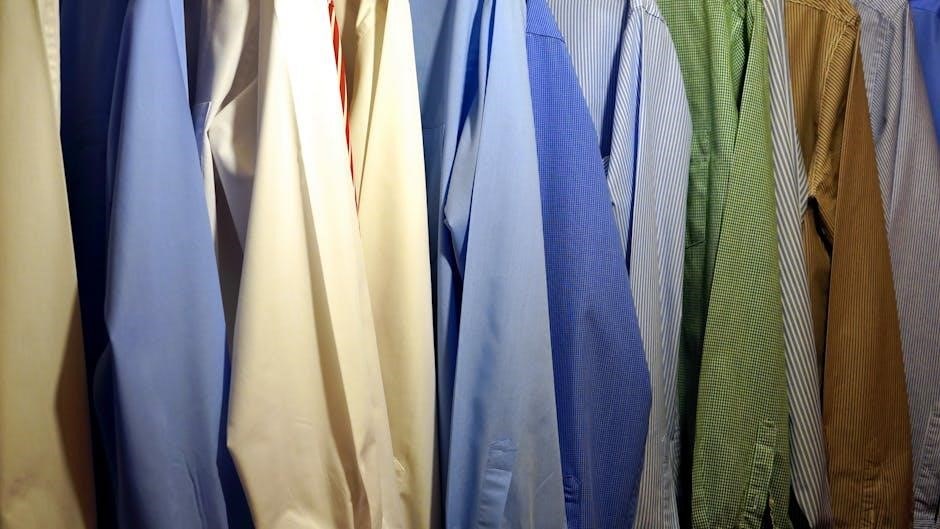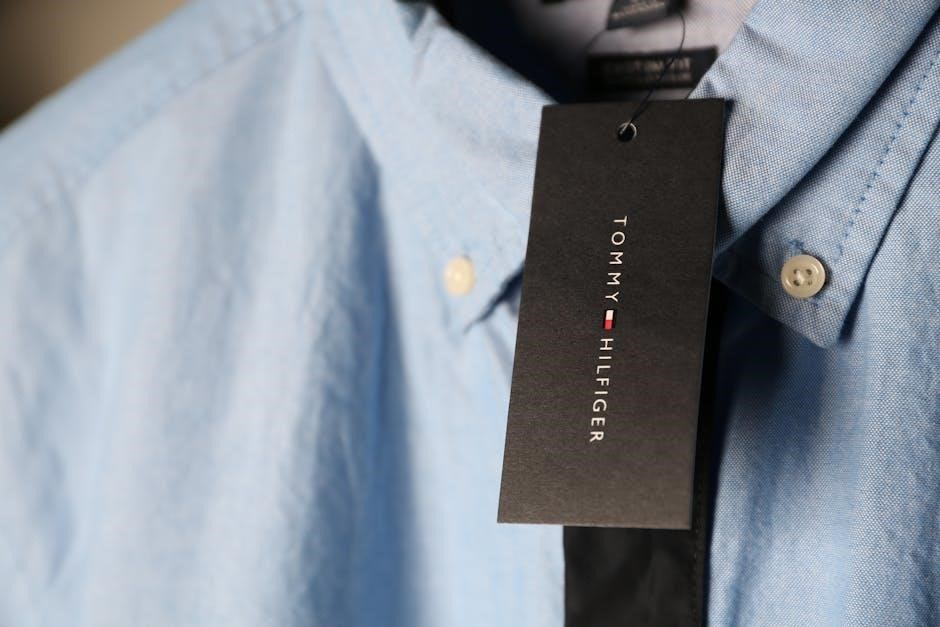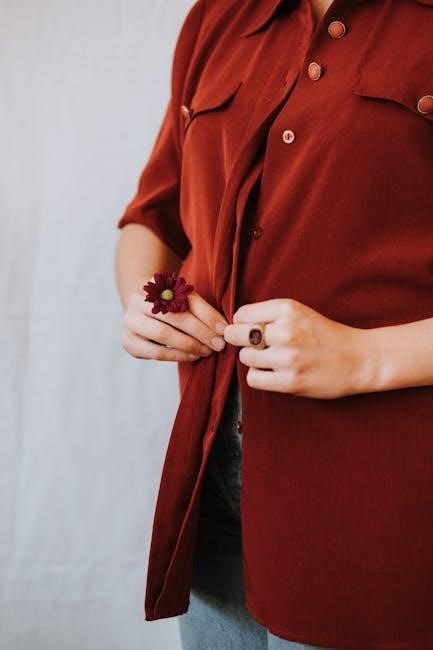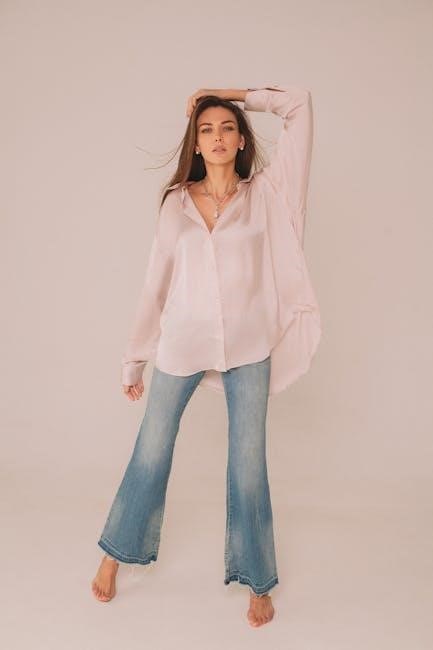A button-down shirt is a classic wardrobe staple, known for its timeless style and versatility. Featuring a collar with button closures, it offers a polished yet casual look. Perfect for dressing up or down, this shirt suits various occasions, from formal events to everyday wear. Understanding proper sizing is key to ensuring comfort and confidence, making it essential to explore size guides and fit options.
1.1 What Is a Button-Down Shirt?
A button-down shirt is a classic style featuring a collar with buttons to fasten the collar points down. This design, originally created for British polo players, prevents the collar from flapping during activity. Typically made from high-quality fabrics like Oxford cloth, it offers a polished yet casual look. The shirt is versatile, suitable for both formal and informal occasions, and is characterized by its timeless design, comfort, and practicality.
1.2 Importance of Proper Fit
A proper fit is crucial for both style and comfort in a button-down shirt. A well-fitting shirt enhances confidence, creating a polished and put-together look. Conversely, an ill-fitting shirt can feel restrictive or unflattering, detracting from its intended appeal. Ensuring the right size and fit ensures the shirt drapes naturally, complementing the wearer’s physique. Whether dressing for a formal event or a casual outing, a button-down shirt’s effectiveness hinges on its fit, making it essential to prioritize accurate sizing and tailored comfort.
Understanding Button-Down Shirt Measurements
Button-down shirt measurements focus on neck size, sleeve length, chest, and body width. These dimensions ensure a comfortable, flattering fit, guiding size selection for optimal comfort and style.
2.1 Neck Size: The Primary Measurement
The neck size is the most critical measurement for a button-down shirt, ensuring the collar fits comfortably. It is measured around the base of the neck, where the collar sits. Typically, neck sizes range from 13 to 19 inches in half-inch increments. A well-fitting collar should neither be too tight nor too loose, allowing room for one finger. Accurate neck measurement is essential for selecting the correct size and achieving a polished appearance.
2.2 Sleeve Length: From Collar to Cuff
Sleeve length is a vital measurement for ensuring a proper fit. It is measured from the center of the collar to the edge of the cuff. This ensures the sleeves are neither too short nor too long, providing comfort and a tailored appearance. Accurate sleeve length is essential for maintaining the shirt’s balance and style, making it a key factor in achieving the perfect fit for any body type or preference.
2.3 Chest and Body Width: Ensuring Comfort
Chest and body width measurements are crucial for a comfortable fit. The chest width is measured across the front, from armpit to armpit, ensuring the shirt isn’t too tight or loose. Body width contributes to the overall silhouette, affecting how the shirt drapes on the torso. Proper chest and body measurements ensure freedom of movement and a flattering, balanced appearance, making them essential for selecting the right size and style of button-down shirt.
2.4 Shoulder and Waist Measurements
Shoulder measurements ensure the shirt sits properly, with seams aligning at the shoulder tips. Waist measurements determine the shirt’s taper, affecting its fit around the midsection. Accurate shoulder and waist measurements prevent a boxy or overly tight appearance, ensuring a balanced, tailored look. These measurements, combined with chest size, help achieve a flattering silhouette, making them vital for a comfortable and stylish button-down shirt fit.

How to Measure Yourself for a Button-Down Shirt
Measuring yourself accurately ensures the best fit for a button-down shirt. Start with your neck circumference, then measure sleeve length from the collar to cuff. Next, measure your chest width by wrapping the tape around the fullest part of your chest. Waist and hip measurements help determine the shirt’s taper. Finally, measure your shoulders from seam to seam. Use a flexible tape measure and stand up straight for precise results.
3.1 Measuring Your Neck Circumference
To measure your neck circumference, wrap a flexible tape measure around the base of your neck, where a collar would naturally sit. Keep the tape level and snug but not tight. This measurement determines the collar size of your button-down shirt. For accuracy, the tape should be parallel to the floor and not digging into your skin. If you don’t have a tape measure, use a well-fitting shirt as a reference by measuring its collar from button to buttonhole. Record this measurement precisely for the best fit.
3.2 Measuring Sleeve Length Accurately
To measure sleeve length, start at the center back of your neck, just below the base, and run the tape measure straight down to the cuff of your shirt. Keep your arm relaxed at your side. The tape should follow the natural curve of your shoulder and arm. Ensure the measurement is straight and not angled. If using a well-fitting shirt as a reference, measure from the center back collar to the end of the cuff. This ensures the sleeve length aligns with your body proportions for a perfect fit.
3.3 Chest Measurement: Armpit to Armpit
Measure your chest by placing the tape measure under your armpits, ensuring it is parallel to the floor. The tape should wrap around the fullest part of your chest, typically just under the armpits. Keep the tape snug but not tight. This measurement helps determine the shirt’s body width, ensuring a comfortable fit without excessive tightness or looseness. Note that this measurement does not include shoulder or waist dimensions, focusing solely on chest circumference for accurate sizing.
3.4 Waist and Hip Measurements for Fit
Measure your natural waistline, typically the narrowest point above your hips, and your hip circumference, usually 7-9 inches below the waist. These measurements help ensure the shirt fits comfortably around your torso. The waist measurement ensures the shirt isn’t too tight or loose, while the hip measurement aids in determining the shirt’s drape and fit, especially for tailored styles. Accurate measurements here contribute to a balanced and flattering silhouette in button-down shirts.
3.5 Shoulder Measurement: Seam to Seam
Measure across the back from one shoulder seam to the other, following the natural curve of your shoulders. This ensures the shirt sits properly, neither too tight nor too loose. The shoulder measurement is critical for a balanced fit, as it affects how the shirt drapes and aligns with your body. Accurate shoulder measurement helps prevent issues like drooping sleeves or a misaligned collar, ensuring a polished and comfortable appearance in your button-down shirt.

Button-Down Shirt Size Charts
Button-down shirt size charts provide standardized measurements for neck, chest, sleeve length, and body width, helping determine the best fit. Charts vary by brand but typically include sizes from S to XXXL, ensuring a tailored fit for all body types.
4.1 Standard Size Chart for Men
The standard size chart for men’s button-down shirts typically includes measurements for neck, chest, and sleeve length. Sizes range from Small to XXXL, with neck measurements increasing in half-inch increments. For example, a Small might have a 14-14.5″ neck, 34-36″ chest, and 32-33″ sleeve length, while an XXL offers a 18-18.5″ neck, 46-48″ chest, and 36-37″ sleeve. These measurements ensure a tailored fit, accommodating various body types and preferences.
4.2 Size Chart for Women
Women’s button-down shirts follow a size chart that typically ranges from XS to XXL, with measurements focusing on chest, waist, and sleeve length. For example, an XS might have a 32-34″ chest, 25-26″ waist, and 30-31″ sleeve, while an XXL offers a 46-48″ chest, 38-40″ waist, and 34-35″ sleeve. These measurements ensure a flattering fit, catering to diverse body types and personal style preferences. Numeric sizing is also used, such as 0-2 (XS) to 24-26 (XXL), for easier selection based on standard fit guidelines.
4.3 Plus Size Chart for Men and Women
The plus size chart for button-down shirts offers extended sizing, ensuring comfort and style for all body types. Men’s sizes range from 2XL to 6XL, with chest measurements from 50-52″ to 62-64″ and sleeve lengths from 36-37″ to 42-43″; Women’s plus sizes include 1X to 6X, with chest measurements from 44-46″ to 58-60″ and sleeve lengths from 33-34″ to 39-40″. These charts provide a tailored fit, accommodating larger frames while maintaining the classic button-down aesthetic and functionality.
Understanding Fit Types
Button-down shirts come in Slim Fit, Regular Fit, and Relaxed Fit options, catering to different body types and preferences for a tailored, classic, or casual look;
5.1 Slim Fit: Tailored and Modern
Slim Fit button-down shirts offer a contemporary, streamlined look with a narrower cut through the chest, sleeves, and body. Designed for a modern aesthetic, they provide a tailored appearance while maintaining comfort. Ideal for those with a lean or athletic build, Slim Fit shirts skim the body without feeling restrictive. They pair well with tailored trousers or jeans for a polished yet casual style. Ensure proper sizing, as Slim Fit shirts may run slightly smaller than Regular Fit options.
5.2 Regular Fit: Classic and Comfortable
Regular Fit button-down shirts are a timeless choice, offering a balanced silhouette that combines comfort and style. They feature a slightly looser cut than Slim Fit shirts, providing ease of movement and a relaxed feel. Suitable for most body types, Regular Fit shirts are ideal for everyday wear, ensuring a classic look that is neither too tight nor too loose. They are versatile enough to pair with both formal and casual attire, making them a wardrobe essential for any occasion.
5;3 Relaxed Fit: Loose and Casual
Relaxed Fit button-down shirts offer a loose, casual silhouette, perfect for a laid-back style. They feature a roomier cut through the chest, shoulders, and body, providing maximum comfort and ease of movement. Ideal for larger body types or those who prefer a more relaxed look, Relaxed Fit shirts are versatile and suitable for casual outings or layering. They maintain a comfortable fit without feeling restrictive, making them a great choice for everyday wear in a relaxed setting.
Brand-Specific Sizing Variations
Brands often have unique sizing standards, so measurements can vary significantly. Always consult the specific brand’s size chart, as some may run smaller or larger than traditional fits.
6.1 Differences in Sizing Across Brands
Brands often have distinct sizing approaches for button-down shirts, leading to variations in measurements. Some brands offer slim-fit designs, while others provide classic or relaxed fits. For instance, certain brands may cater to specific body types, such as tall or athletic builds. Additionally, fabric weight and cut can influence how sizes fit. It’s crucial to refer to each brand’s size chart, as differences in chest, shoulder, and sleeve measurements can significantly impact the overall fit.
6.2 How to Adjust for Brand-Specific Fits
Adjusting for brand-specific fits requires careful consideration of their sizing charts and your body measurements. Compare your neck, chest, and sleeve measurements to the brand’s size guide. If a brand runs small, consider sizing up. Conversely, if it runs large, size down. Pay attention to fit descriptions like slim, regular, or relaxed to ensure the shirt aligns with your preferred style and comfort level. This tailored approach ensures a flattering and comfortable fit across different brands.
Common Mistakes to Avoid
Common mistakes include ignoring sleeve length, not considering body type, and overlooking fabric thickness when selecting sizes, leading to poor fit and discomfort.
7.1 Ignoring Sleeve Length
Ignoring sleeve length is a common mistake that can ruin the fit of a button-down shirt. Sleeves that are too long or too short can make the shirt look ill-fitting and unpolished. Proper sleeve length should reach the midpoint of the thumb when arms are at your sides. Always measure from the center back of the collar to the cuff to ensure accuracy. Many size charts provide sleeve length measurements, so referencing them is crucial for the perfect fit.
7.2 Not Considering Body Type
Not considering body type is another common oversight when selecting a button-down shirt. Different body types require tailored fits to ensure comfort and a flattering appearance. For example, broader shoulders may need a slightly roomier fit, while slimmer frames might prefer a slim or tailored cut. Ignoring body type can lead to an ill-fitting shirt, with sleeves that are too tight or a shirt body that hangs awkwardly. Always choose a style that complements your physique for the best results.
7.3 Overlooking Fabric Thickness
Overlooking fabric thickness can significantly impact the fit of a button-down shirt. Thicker fabrics, such as flannel or Oxford cloth, may add bulk, requiring a slightly larger size for comfort. Thinner fabrics, like cotton voile, drape differently and may fit more snugly. Failing to consider fabric weight can result in a shirt that feels too tight or too loose, undermining the overall fit and appearance. Always account for fabric thickness when selecting your size for optimal comfort and style.

How to Choose the Right Size
Use size charts and measure accurately to ensure the best fit. Compare your measurements with the chart and consider your current shirts for consistency and comfort.
8.1 If You’re Between Sizes
If your measurements fall between two sizes, consider your fit preference. For a slimmer look, size down; for comfort, size up. Some brands recommend sizing up if their shirts run smaller. Personal preference and intended use also matter—casual shirts may allow a looser fit, while dress shirts should be more tailored. Always consult the size chart and compare with your current shirts for the best decision.
8.2 Considering Personal Preference
Personal preference plays a significant role in choosing the right size. Some prefer a slim, tailored fit for a modern look, while others opt for a looser, more casual style. Consider your body type, lifestyle, and how you want the shirt to feel. If you’re unsure, try it on or compare measurements with a shirt you already own. Fabric thickness and intended use can also influence your decision, ensuring the perfect balance between comfort and aesthetic appeal.
The Role of Fabric in Sizing
Fabric weight and stretch significantly impact fit. Heavier fabrics may feel tighter, while lightweight ones drape more freely, affecting how sizes correspond to body measurements and comfort.
9.1 How Fabric Weight Affects Fit
Fabric weight plays a crucial role in how a button-down shirt fits. Heavier fabrics, like thick oxfords, provide structure but can feel restrictive if sized too tightly. Lightweight fabrics, such as cotton voile, offer a loose, breathable fit. Seasonal fabrics also influence sizing choices; for example, summer shirts may require a slightly looser fit for comfort, while winter styles can be more tailored. Understanding fabric weight helps in selecting the right size for optimal comfort and appearance.
9.2 Seasonal Fabrics and Sizing Adjustments
Seasonal fabrics influence button-down shirt sizing due to variations in weight and drape. Heavier fabrics, like flannel, may require sizing up for comfort, while lightweight materials, such as linen or cotton, allow for a closer fit. Summer shirts often feature breathable fabrics, necessitating slightly looser cuts for ventilation, while winter styles may need tailored adjustments to accommodate thicker textiles. Understanding these seasonal differences ensures a flattering and comfortable fit year-round.

Alterations and Adjustments
Alterations ensure a button-down shirt fits perfectly, addressing issues like sleeve length, collar tightness, or body width. Tailoring can enhance comfort and achieve a personalized fit.
10.1 When to Consider Tailoring
Tailoring is essential when off-the-rack shirts don’t fit perfectly. If the shoulders don’t align, sleeves are too long, or the body is too tight/loose, consider alterations. Additionally, if the collar gaps or buttons strain, tailoring can resolve these issues. It’s also useful for adjusting sleeve length, darts, or hemlines to match personal style. Tailoring ensures a bespoke fit, enhancing both comfort and appearance, making it worth the investment for a polished look.
10.2 Common Alterations for Button-Down Shirts
Common alterations for button-down shirts often include sleeve shortening or lengthening, darts added for a slimmer fit, and shoulder adjustments for better alignment. Hemming the body or adjusting the collar to fit the neck are also frequent requests. Some opt for tapering the sides or resizing button placements. These tweaks ensure a tailored look without compromising the shirt’s classic appeal, making each piece uniquely suited to the wearer’s proportions and style preferences.
Care Tips to Maintain Fit
Wash button-down shirts inside out in cold water to preserve color and fabric integrity. Avoid over-drying, as heat can shrink or distort the fit. Iron while slightly damp to maintain crispness, and store on a hanger or folded neatly to prevent wrinkles and creases that alter the silhouette.
11.1 Washing and Drying Instructions
For optimal care, wash button-down shirts inside out in cold water using a mild detergent to protect the fabric and colors. Avoid using bleach or harsh chemicals, as they can damage the material. Gently reshape the shirt while damp to maintain its fit and lay it flat or hang to air dry. Avoid high heat in dryers, as it can shrink the shirt or distort its shape. Proper washing and drying techniques help preserve the shirt’s integrity and ensure a lasting fit.
11.2 Ironing and Storage Tips
Iron your button-down shirt while slightly damp to remove wrinkles, using a cool setting to prevent fabric damage. Avoid ironing buttons directly, as heat can cause discoloration. For storage, hang shirts on padded hangers to maintain their shape and prevent creases. Alternatively, fold neatly and store in a cool, dry place. Proper ironing and storage help maintain the shirt’s appearance and extend its lifespan, ensuring it remains a tailored, polished addition to your wardrobe for years to come.
A well-fitting button-down shirt is the foundation of a great wardrobe. By understanding measurements, fabric, and care, you can ensure a polished, comfortable look that lasts, making it a timeless essential.
12.1 Final Thoughts on Finding the Perfect Fit
Finding the perfect fit for a button-down shirt requires attention to detail and understanding your body measurements. By accurately measuring your neck, sleeve length, chest, and waist, you can navigate size charts confidently. Consider fabric thickness and brand-specific fits, as they can impact comfort and appearance. Tailoring is always an option for a tailored look. Regular care, like proper washing and ironing, ensures your shirt maintains its fit and style over time. A well-fitting button-down shirt is not just a piece of clothing—it’s an investment in your personal style and confidence.
